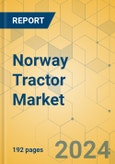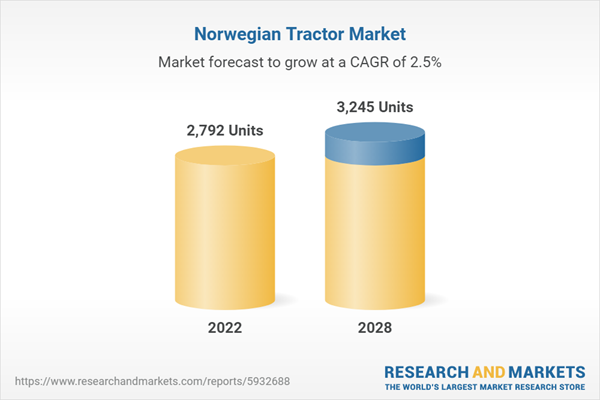Speak directly to the analyst to clarify any post sales queries you may have.
KEY HIGHLIGHTS
- Norway has over 5.4 million food consumers. The country witnessed a massive increase in farm mechanization in terms of agricultural and industrial productivity.
- The Norway tractor market is highly concentrated, with the top players controlling most of the market. Domestic and global brands, on the other hand, are equally represented in the industry.
- The Norwegian government plans schemes and initiatives to facilitate credit and improve agriculture-related operations, which will contribute to the growth of the overall value chain of the market.
- The Norway tractor industry increased by 6% in 2022 from 2021. The increase in crop production and tractor sales was due to government support to farmers and favorable climate conditions.
MARKET TRENDS & OPPORTUNITIES
Increasing Use of Bioenergy in Agricultural Tractors
Conventionally, farmers used diesel engine tractors known for their high power. Tractors are now more efficient and can complete tasks with less power requirements due to advances in machine technologies and engines. The volatility in diesel prices hampers farmers' budget management. Thus, the Norway tractor market witnesses a considerable demand for tractors that run on different fuels, such as plant-oil and biogas-powered tractors.Technological Advances in Tractor Technology
A new frontier of innovation emerged as agriculture met digital technology, opening various paths to an intelligent agricultural future. Tractor manufacturers are competitive, and companies constantly strive to innovate and ensure product differentiation at affordable prices. State-of-the-art technology-based tractors are currently available in the industry. GPS and remote sensing make farming more accurate and productive.SEGMENTATION INSIGHTS
INSIGHTS BY HORSEPOWER
The 101-130 HP segment recorded the highest Norway tractor market share in 2022. The significant factors for the increasing growth of the medium-power (101-130 HP) range of tractors are versatility and adaptability, cost-effectiveness, availability of medium-sized farms, and operational flexibility. Tractors in this HP range can easily handle large fields and heavy-duty mowing tasks. Further, trends driving medium HP range tractor sales in the Norway tractor industry are:- Crop Adaptability: Medium HP range tractors are favored by farmers due to their versatility across various crops, accommodating the diverse agriculture seen in Norway.
- Sustainability Focus: Sustainable farming practices are a priority, and medium-sized tractors, with their efficient power-to-efficiency ratio, align well with eco-friendly approaches.
- Cost-Effective Solutions: In Norway’s competitive agricultural landscape, the medium HP range of tractors offers cost-effective alternatives to larger models, attracting budget-conscious farmers while delivering substantial performance.
Segmentation by Horsepower
- Less Than 50 HP
- 50-70 HP
- 71-100 HP
- 101-130 HP
- 131-170 HP
- 171-200 HP
- 201-250 HP
- Above 250 HP
INSIGHTS BY WHEEL DRIVE
The Norway tractor market is dominated by low-range HP 2WD tractors. 2WD tractors are the most favored by farmers. The low relative cost of ownership, the sufficiency of features and haulage power, and convention make 2WD tractors more popular among farmers. Furthermore, ease of driving and flexibility with light loads and in plain fields are significant factors that boost the demand for two-wheel-drive tractors. John Deere, New Holland, Fendt, and Valtra share most of the 2-wheel drive tractors segment.Segmentation by Wheel Drive
- 2-Wheel-Drive
- 4-Wheel-Drive
REGIONAL ANALYSIS
In terms of region, the eastern and western regions have reportedly shown a higher demand for agricultural tractors than the other regions of the country. During the forecast period, the country's western region will strongly need tractors. Moreover, the Eastern region has a higher level of mechanization than any other country region. It has helped to hold the most prominent share of the Norway tractor market in 2022. Tractors in Eastern Norway typically range from small and compact models for smallholdings and hobby farms to larger, more powerful tractors for more extensive commercial operations. Different tractors are used for various agricultural activities, such as plowing, planting, harvesting, and transporting goods. The agriculture sector in Norway, including Eastern Norway, has been increasingly adopting modern technology in farming practices. Precision agriculture techniques, such as GPS-guided tractors and autonomous machinery, have gained popularity to optimize crop production.Segmentation by Region
- Norway
- Eastern
- Western
- Trøndelag
- Northern
- Southern
VENDOR LANDSCAPE
John Deere, Valtra (AGCO), Massey Ferguson (AGCO), and New Holland (CNH Industrial) dominated the Norway tractor market with a collective market share of over 70% in 2022. These brands have adopted several strategies to gain traction in the industry. The Norway tractor industry is characterized by various global vendors that account for most of the market share. Therefore, it would be difficult for new players to compete with well-established vendors in the industry. The key competitive factors of the Norway tractor industry players include efficiency, product reliability & availability, after-sales service, and price.Key Company Profiles
- John Deere
- AGCO
- CNH Industrial
- Deutz-Fahr
Other Prominent Vendors
- CLAAS
- McCormick
- Iseki
- Branson
- Escorts
- Kubota
- Solis
- TYM Corporation
- LS Tractor
- KIOTI
- Yanmar
Recent Developments in The Norway Tractor Market
- In March 2023, John Deere announced MY24 updates for its 7, 8, and 9 Series Tractors lineup that will help prepare them for the future of precision agriculture.
- In August 2022, AGCO launched the latest Fendt 700 Vario series tractors, featuring an upgraded powertrain with VarioDrive transmission and Fendt iD low engine speed concept. This new generation aims to enhance efficiency and productivity for customers.
- In June 2022, The CLAAS AXION 900 series of large tractors for contractors and big farms the new AXION 900 series are equipped as standard with the updated, continuously variable ZF Terramatic transmission.
- In March 2022, John Deere launched the new electric variable transmission (EVT) for select 8 Series Tractors and a new JD14X engine for 9 Series.
- In February 2022, Massey Ferguson launched the MF 6S series tractors. This machine provides up to 180 HP with advanced technology.
WHY SHOULD YOU BUY THIS REPORT?
This report is among the few in the market that offer outlook and opportunity analyses forecast in terms of:- Market Size & Forecast Volume (Units) 2020-2028
- Segmentation by Horsepower
- Segmentation by Drive Type
- Segmentation by Region
- Production and trade values
- Major current and upcoming projects and investments
- Competitive intelligence about the economic scenario, advantages in Norway, industry dynamics, and market shares
- Innovative technologies
- Company profiles of primary and other prominent vendors
- Market shares of major vendors
KEY QUESTIONS ANSWERED:
1. What are the expected units sold in the Norway tractor market by 2028?2. What is the growth rate of the Norway tractor market?
3. How big is the Norway tractor market?
4. Which region holds the largest Norway tractor market share?
5. Who are the key companies in Norway's tractor industry?
Table of Contents
Companies Mentioned
- John Deere
- AGCO
- CNH Industrial
- Deutz-Fahr
- CLAAS
- McCormick
- Iseki
- Branson
- Escorts
- Kubota
- Solis
- TYM Corporation
- LS Tractor
- KIOTI
- Yanmar
Methodology
Our research comprises a mix of primary and secondary research. The secondary research sources that are typically referred to include, but are not limited to, company websites, annual reports, financial reports, company pipeline charts, broker reports, investor presentations and SEC filings, journals and conferences, internal proprietary databases, news articles, press releases, and webcasts specific to the companies operating in any given market.
Primary research involves email interactions with the industry participants across major geographies. The participants who typically take part in such a process include, but are not limited to, CEOs, VPs, business development managers, market intelligence managers, and national sales managers. We primarily rely on internal research work and internal databases that we have populated over the years. We cross-verify our secondary research findings with the primary respondents participating in the study.

LOADING...
Table Information
| Report Attribute | Details |
|---|---|
| No. of Pages | 192 |
| Published | February 2024 |
| Forecast Period | 2022 - 2028 |
| Estimated Market Value in 2022 | 2792 Units |
| Forecasted Market Value by 2028 | 3245 Units |
| Compound Annual Growth Rate | 2.5% |
| Regions Covered | Norway |
| No. of Companies Mentioned | 15 |









